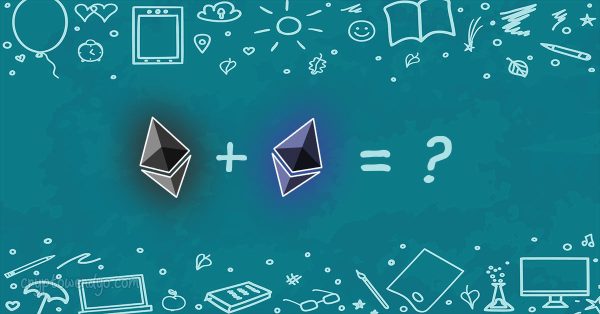


With the Ethereum Proof of Stake merge happening roughly five days from the time I’m writing this article, we thought it might be good to go over what exactly is happening, what it means for Ethereum moving forward, and hopefully clear up any misconceptions folks might have along the way.
The Merge is what was previously being called “Ethereum 2.0”. While a lot of folks are acting like the transition to Proof-of-Stake was something they just started hearing about in 2018, or 2020 when the Beacon Chain launched – this exact transition was already predicted in the Ethereum whitepaper, way back in 2013.

The important thing to note here is the issuance, being that this is probably the biggest change you will see, immediately, from the Merge.
With the burn mechanisms introduced by EIP-1559, in simulations the Merge’s immediate & long-term effects are dramatically limited inflation of Ethereum’s supply, if not making it fully deflationary.

What you won’t see in the immediate aftermath is lower gas prices for your transactions. Not in all likelihood, anyway. The merge is more about hot-swapping the Proof of Work chain’s “energy waste” for Proof of Stake’s “energy efficiency”.
I say this with some distaste in my mouth, because I have my own opinions about the medium-term benefits Proof of Work has on incentivizing more efficient renewables & more widespread adoption of micro-grids & self-generation – I digress, if only for the sake of getting through the important stuff.
HOWEVER, the merge to Proof of Stake is the next step in the process for adding sharding and other improvements, which do have the potential for much lower transaction cost, and also a host of other issues that will need to be discussed & dealt with.
So, what you have to understand about how Ethereum works, between the layers, nodes, etc. is that there is a Consensus Layer (currently PoW) and an Execution Layer (EVM). These are two parts of one whole, but in anticipation of the Merge they were essentially unbundled, with the Beacon Chain launching in December of 2020 to begin testing in production as a Consensus Layer without the billions of dollars that depending on the Execution Layer being affected.
See, the Merge is a tricky thing. It’s like you’re driving the second pricest car that exists down the interstate, and suddenly you want to transition from an internal combustion engine to an electric one. Well, that’s a noble goal, I guess. How do you do it without stopping the car or crashing?
As far as the Ethereum developers figure, the trick is to lower the electric engine into the car, and begin letting it run without any critical systems depending on it. The car is still using the gas engine; the electric one is just humming along to prove that it can.
When the merge happens, the “car” will switch over to the “electric/PoS” engine.
There’s some complicated stuff going on here, though, because you have clients on both ends that need to start communicating with each other.
The Consensus Layer clients that have been functioning on Beach Chain, like Lighthouse, Teku, and Prysm will start receiving blocks from the Execution Layer clients like Geth, Nethermind, and Erigon which are the fundamental execution layer backbone of nodes.
Source: ethereum.org
So what happens to the Proof of Work layer when this happens? Well, clients that aren’t updated would continue processing on the Proof of Work chain & wouldn’t be interacting with “actual” Ethereum, as in the PoS Ethereum.
So if services are using outdated clients, you could potentially see some issues there. As of two days before this writing, some 74% of clients were showing “Merge-Ready”, after the Bellatrix upgrade preparing for PoS communication.
When I say “preparing for communication”; again, as Ethereum currently exists, mainnet node operators were running nodes built on implementations like Geth, Nethermind, etc, and node operators on the Beacon Chain were using the Consensus Layer clients.
Post-Merge, a full node will require updating both, and them authenticating each other using a JWT secret. Sounds complicated? It is! Exciting times, yeah?
I mean…it might? It won’t. I mean, it almost definitely won’t. If something did emerge, and someone did provide liquidity for it – you have to ask yourself what dapps, exchanges, etc. are really going to be able to pick it up & roll with Ethereum and have it actually matter?
At that point it’s just as likely that the hashrate flows to Ethereum Classic, or to an entirely new chain running ethash. I could be wrong, and that’s honestly the most exciting thing about this. You might well seem some feints & attempts to make the Proof of Work chain viable in the aftermath of the Merge, but the Ethereum developers left them several “presents” that make that harder, and would have to be deprecated via yet another hard fork which would require more updates & consensus from the remaining nodes.
And, the thing is, a fair number of the nodes that haven’t updated – just aren’t going to. They’re just running somewhere, forgotten. So the idea that you wake them up & get them to update to another fork is a little silly; more likely that new nodes spring up out of base speculation.
BUT I DIGRESS. Let’s talk about the presents that would almost make this a necessity.

The Difficulty Bomb: The Difficulty Bomb was a mechanism to incentivize miners away from continuing on PoW ETH, and to encourage developers to push towards the PoS as the threat of the difficulty bomb has been ever-looming & has been delayed several times.
In the short-term, the PoW ETH chain would still be mineable, although where you’d be able to exchange that ETH is another question entirely.
As the merge is triggered at a predefined difficulty (terminal total difficulty) as opposed to block height, depending on hashrate the difficulty will be reached, PoW will tick over to PoS, and the remaining PoW chain will just get more difficult until the point where it becomes unusable.
So, continuity would necessitate another hard fork. The other “present” is that they’ll be competing with a PoS ETH that has decreased issuance as dramatically as three Bitcoin “halvenings”. Prior to the merge, issuance was 13,000 ETH/day to miners, with something like 1,800 ETH being burned on a day like today, post EIP-1559.
After the merge, issuance will be 1,600 ETH/day to stakers, and if burn numbers held – Ethereum would actually be deflationary, although more likely you’d just see a minimal or near-zero increase in issuance, annually.
I dunno…usually? Anything could happen. That’s what makes it exciting. I can do my best to speculate on what the seemingly obvious consequences of some things are, but we’re rowing into uncharted territory with a multi-billion dollar boat.
As far as your dapps & everything else goes? You should be fine. I mean, if they didn’t update the clients their protocol relies on, you might have some issues. I wouldn’t necessarily try to interact with a lot of stuff right around the time the merge is happening, but say, if you have liquidity staked in a uniswap LP or something – all of that ought to transition smoothly.
In general, I’d caution to risk as little as possible as we get closer to the Merge, and maybe consider the need for developers on any PoW chain that might rise up from the ashes of the difficulty bomb. Not financial advice. Not now; not ever.
Until next week, let’s consider watching the madness from a comfortable distance & appreciating the fact that we live in exciting times, in an exciting place.

Torrent/seedbox aficionado, decentralist, cultural archivist, fundamental analyst, podcast addict, shitcoin-sifter extraordinaire
Tip Jar
BTC: bc1qahxrp47hpguhx8y8r382dekgca34tlv54aufht
Doge: DJRy9gGSUGeyXfVcZXzKLkBv7RmDLv3MhJ
Share This Article
Join 10,000+ forward thinkers! Get crypto education in your inbox.